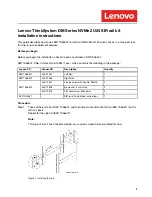
PoE Port Status LEDs
B-2 About PoE (Power over Ethernet)
PoE Port Status LEDs
The
PoE
port
status
of
each
10/100/1000
Mbps
RJ45
port
on
an
S
‐
Series
I/O
module
is
indicated
by
the
two
‐
color
RX
and
TX
LED
display
for
each
port.
To
observe
the
PoE
port
status
indications,
you
must
switch
the
S
‐
Series
I/O
module
from
the
default
RX/
TX
Status
Mode
to
the
PoE
Port
Status
Mode
using
the
red
PoE
button.
The
switch
operation
and
a
description
of
how
to
use
the
LED
indications
are
described
in
the
Enterasys
S
‐
Series
Module
Hardware
Installation
Guide
.
Allocation of PoE Power to Devices
When
equipped
with
a
PoE
subsystem
and
S
‐
POE
‐
PS
power
supplies,
the
S
‐
Series
chassis
provides
dedicated
PoE
power
for
powered
devices
(PDs)
attached
to
the
10/100/1000
Mbps
RJ45
ports
on
the
installed
S
‐
Series
I/O
modules.
The
S
‐
Series
firmware
determines
the
power
available
for
PoE
based
on
power
supply
status
and
power
supply
redundancy
mode.
When
any
change
is
made
to
the
power
supply
status
or
redundancy
mode,
the
firmware
recalculates
the
power
available
for
PoE.
The
power
available
for
PoE
is
distributed
based
on
the
configured
allocation
mode:
•
Automatic
mode
(default),
in
which
available
power
is
distributed
evenly.
Any
change
in
available
power,
due
to
a
change
in
power
supply
status
or
redundancy
mode,
will
trigger
an
automatic
redistribution
of
power.
•
Manual
mode,
in
which
the
power
budget
is
manually
configured,
using
either
CLI
commands
or
the
MIBs.
The
wattage
configured
cannot
exceed
the
total
power
available
on
the
switch
for
PoE.
The
configured
wattage
assignment
is
used
to
calculate
the
total
available
PoE
power.
If
the
total
available
PoE
power
changes,
a
redistribution
of
available
power
will
occur,
applying
the
calculated
percentage.
If
the
PoE
power
needed
or
requested
exceeds
the
power
available,
the
system
will
generate
a
trap
to
notify
the
system
manager.
For
more
information
on
configuring
allocation
mode,
see
the
Enterasys
S
‐
Series
CLI
Reference
Guide
.
Management of PoE Power to PDs
You
can
configure
how
the
S
‐
Series
chassis
makes
power
available
to
attached
PDs:
•
Real
‐
time
mode
(default),
in
which
the
PoE
controller
calculates
the
power
needed
by
a
PD
based
on
the
actual
power
consumption
of
the
attached
devices.
•
Class
mode,
in
which
the
PoE
controller
manages
power
based
on
the
IEEE
802.3at
definition
of
the
class
limits
advertised
by
the
attached
devices.
In
this
mode,
the
maximum
amount
of
power
required
by
a
device
in
the
advertised
class
is
reserved
for
the
port,
regardless
of
the
actual
amount
of
power
being
used
by
the
device.
For
more
information
on
configuring
power
management
mode,
see
the
Enterasys
S
‐
Series
CLI
Reference
Guide
.
Summary of Contents for S4-Chassis
Page 2: ......
Page 12: ...x...
Page 16: ...xiv...
Page 20: ...Getting Help xviii About This Guide...
Page 28: ...Features 1 8 Introduction...
Page 62: ...Completing the Installation 3 32 Chassis Setup...



























